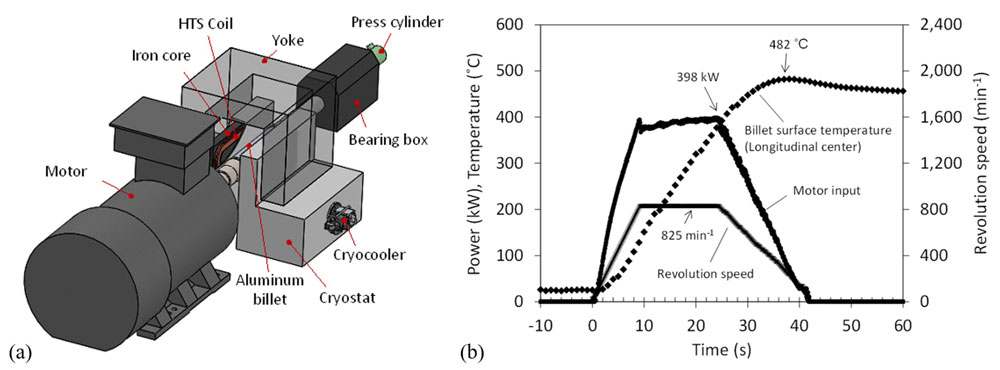AP2-2-INV
Development of 400 kW class induction heating device for aluminum billets using HTS magnet
Nov. 29 14:30-15:00
*Satoshi Fukui1, Tetsuya Ito1,2, Jun Ogawa1, Hiroshi Kawashima2, Yasuhiro Ogata2, Takayuki Sho2, Mitsuho Furuse3, Tomonori Watanabe4, Shigeo Nagaya4, Yuki Morishita5, Nobuyuki Fuyama5, Takashi Nagaoka5, Norio Nawachi5
Niigata University1
TERAL Inc.2
National Institute of Advanced Industrial Science and Technology3
Chubu Electric Power Co., Inc.4
Hiroshima Prefectural Technology Research Institute5
High frequency AC induction heating methods are commonly used for billet heating in aluminum hot extrusion processes. In the aluminum industry, development of highly efficient and fast heating methods of aluminum billets is expected, since the energy efficiency of conventional high frequency AC induction heating of aluminum billets using water-cooled Cu coils is generally low [1]. The induction heating by rotating the aluminum billet in strong DC magnetic field called DC induction heating [2, 3] has been proposed and its high efficiency has also been demonstrated. By applying HTS magnets for the DC induction heating, it is possible to significantly improve the heating capacity and the energy efficiency compared to the conventional induction heating method. We have been developing an aluminum billet heater using a HTS magnet for the extrusion processes. The target heating capacity for heating a 6 inch x 500 mm aluminum billet from 20 degrees Celsius to about 500 degrees Celsius within 60 seconds is 400 kW. The schematic overview of our billet heater is shown in Fig. 1(a).
This demonstration machine consists of the drive unit of aluminum billet, the HTS magnets and an aluminum billet grasping mechanism. The aluminum billet is rotating by using the inverter-fed induction motor of 400 kW output. The HTS magnet with an iron core is used to improve the efficiency of the magnetic circuit. The HTS coil is wound directly around the iron core. This part is located in a cryostat and cooled to cryogenic temperature. The backs of the two sets of HTS coils are connected by a yoke placed at room temperature. This structure can effectively save the necessary amount of HTS tapes in the coils. The detail design and test results of the HTS magnet has been reported in [4]. The aluminum billet grasping mechanism transmits a rotational force from the drive unit to the aluminum billet. In our billet heater, the maximum heating capacity is 400 kW at 900 min-1, therefore the necessary transmit torque to the billet is about 4.2 kN∙m. To transmit this large torque, the grasping system needs to press an aluminum billet with a force of hundreds of kN (around 500 kN). Since the mechanical hardness of aluminum strongly affects the grasping property, we measured the temperature dependence of mechanical properties of aluminum. According to this measurement result, the grasping force control system was developed. Using the demonstration machine, the heating test was conducted on an aluminum billet (A6063) with 155 mm in diameter and 500 mm long. Fig. 1(b) shows the time traces of billet temperature, revolution and input power to the drive motor when the coil current was 180 A (096 T at center). As shown in Fig. 1(b), the billet temperature reached about 482 °C after 42 seconds. The maximum motor input was about 398 kW. From the results of heating tests, we found that the energy efficiency including the refrigeration power was about 74 %.
In the presentation, the detail of the design and fabrication of our test apparatus is summarized and the R & D status are reported.
Fig. 1. (a) Schematic diagram of the aluminum billet heater under developing (b) Result of heating test
[1] P. G. Simpson, INDUCTION HEATING – Coil and System Design -, McGraw-Hill, 1960.
[2] M. Fabbri, M. Forzan, S. Lupi, A. Morandi, and P. L. Ribani, “Experimental and Numerical Analysis of DC Induction Heating of Aluminum Billets,” IEEE Trans. Magn., vol. 45, no. 1, pp. 192-200, Jan. 2009.
[3] R. Araneo, F. Dughiero, M. Fabbri, M. Forzan, A. Geri, A. Morandi, S. L. Lupi, P. L. Ribani, and G. Veca, “Electromagnetic and thermal analysis of the induction heating of aluminum billets rotating in DC magnetic field,” COMPEL Int. J. Comput. Math. Electr. Electron. Eng., vol. 27, no. 2, pp. 467-479, 2008.
[4] T. Ito, Satoshi Fukui, Hiroshi Kawashima, Yasuhiro Ogata, Mitsuho Furuse, Tomonori Watanabe, Shigeo Nagaya, and Jun Ogawa: “Fabrication and Test of HTS Magnet for Induction Heating Device in Aluminum Extrusion Processing”, IEEE Transactions on Applied Superconductivity, Vol.32, No.4, (2022), Art. no. 4600205.
Keywords: HTS magnet, Induction heating
